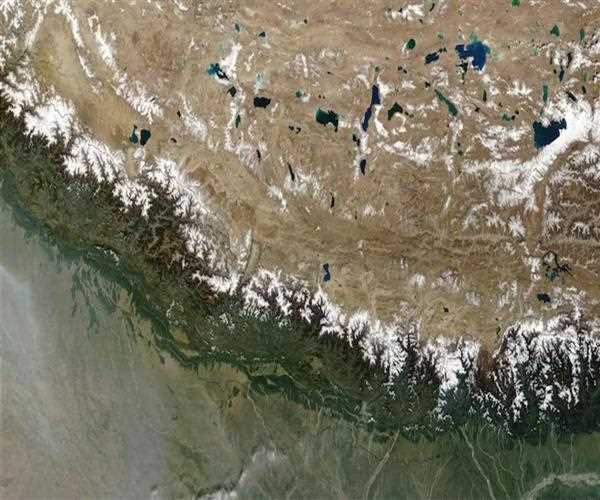
19-Jan-2024 , Updated on 1/19/2024 9:48:10 PM
Division in Indian Tectonic Plates Beneath Tibet Region
The Himalayan mountains, which are known for their spiritual importance and appear to be a beautiful example of nature’s beauty, have hidden puzzles underlying the geological world. The recent studies forced us to look past the features of these mountains and find a movement beneath where nature keeps hidden her secrets. The research suggests that that hidden beneath the rocky features and face of the Himalayas there is an undetected movement between India and Tibet, caused by underplating. This helps us look into the moving powers forming Earth’s wonders, inspiring both researchers and amateur explorers to think about what happens because of these changes.
The Historic Movement of Plates
60 million years ago the Indian-Eurasian tectonic plates collision initiated Himalayan formation. India collided with Eurasia, which resulted in the formation of the Himalayas and the creation of the world’s tallest peaks.
But this is not a rare case of collision; it’s an ongoing geological movement. The Indian and Eurasian plates continue their interaction resulting in the growth of the Himalayan Mountains even at present. However, in this coordinated movement of tectonic elements, a very strange turn has been discovered.
Chaos Below: The Plate Peeling
In classical theory, the Indian plate was thought to smoothly slide under the Eurasian since they have similar densities. However, some recent research indicated what is happening under the surface. It is called “delamination” or peeling. The upper part of the Indian plate appears to be detaching from its weightier lower shell, thus leading to a crack beneath Tibet.
Understanding Delamination
Delamination, from a geological perspective, is the process of separation or peeling away thus segmenting one part of a tectonic plate such as the Indian plate in this case form an underlying layer. This, however, introduces the challenge with traditional ideas of a smooth subduction that takes place in cases of plate collisions along continental lithosphere.
For the Indian plate, the buoyant upper crust appears to tail from its denser lower layer adding another complication that arises in collision with the Eurasian plate. Although the complex dynamics of delamination are yet to be completely understood, research efforts seek to understand these mechanisms and ramifications.
Key Points:
1. Separation of Layers: Delamination means the peeling off of an upper, buoyant crust from a denser lower layer in tectonic plates.
2. Contrast with Subduction: It contradicts the traditional perception of smooth subduction, where a plate is pushed under another due to differences in densities.
3. Vertical Split: It leads to the vertical separation downward from an area, for example, Tibet, which makes a more complicated geological setting.
4. Tectonic Complexity: The delamination adds an additional level of complication onto the tectonic interactions, proving how Earth’s crust is constantly changing.
The Delicate Balance
The balance between the upper and lower Indian plates is shaky which contradicts with classical theory of plates. This unusual behavior raises questions about the way continental plates, especially those with similar densities behave in ways that were previously unobserved.
In southern Tibet, Lin Liu of the Ocean University of China and colleagues analyzed 94 stations’ seismic data. Their results indicate a major break in the Indian plate, contrasting with what we thought was known about how tectonic plates operate.
Increasing Earthquakes?
This discovery isn’t merely redefining the concepts of mountains; it also has earthquake forecasting in store. Risky earthquakes could be caused by this "slab tear" beneath Tibet. If scientists could understand the three-dimensional motion of tectonic plates, then they would be able to predict more accurately seismic events.
Tearing and peeling below the crust is a very important information tool that can be used to identify areas prone to earthquakes. This information could assist in refining the predictions of earthquake hazards, thereby enabling appropriate precautionary measures to be introduced where necessary along the plate boundary.
More Exploration and Learning needed
The conclusion about the possible separation of the Indian plate reminds us of how our planet is constantly changing. With these forces defining our world, life-long learning has become inevitable. Although we are not completely clear how these movements result in surface stress, this study is an important leap toward understanding what takes place underneath the earth’s crust.
The Unpredicted Geology
In conclusion, the motion below Tibet makes us question what we consider to be sure that gives an idea of a much more complicated picture of how tectonic plates act. The potential separation in the Indian plate gives us an indication of future earthquakes due to the movement of the plates. It also forces us to learn more about these movements and how our planet came into existence. We see this geological movement unfolding before us, and it is more than just surprising and possibly dangerous—it also urges geologists and human beings to explore scientific knowledge about our earth's movement further.

Content writer
I am a content writter !
Join Our Newsletter
Subscribe to our newsletter to receive emails about new views posts, releases and updates.
Copyright 2010 - 2025 MindStick Software Pvt. Ltd. All Rights Reserved Privacy Policy | Terms & Conditions | Cookie Policy